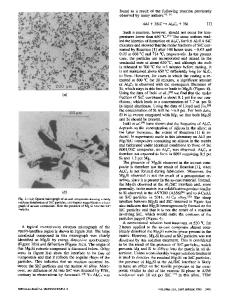Effect of SiC p volume fraction on the microstructure and tensile properties of SiC p /2024 Al-based composites prepared
- PDF / 1,924,369 Bytes
- 13 Pages / 584.957 x 782.986 pts Page_size
- 86 Downloads / 477 Views
A new technology for preparing and forming ceramic particle-reinforced metal matrix composites, powder thixoforming, has been proposed. The effect of the SiCp volume fraction on the microstructure and tensile properties of thixoforged SiCp/2024 Al-based composites was studied. The results indicated that the volume fraction affected the effective liquid fraction, primary particle size and shape, and microstructure compactness. A composite with 10 vol% SiCp had the best comprehensive tensile properties, an ultimate tensile strength of 388 MPa, a yield strength of 295 MPa, and an elongation of 3.8%, representing increases of 29.3 and 33.5%, and a decrease of 63.5%, respectively, compared with the values for the thixoforged 2024 Al matrix alloy. During tensile testing, cracks were initiated in the secondary solidified structures, the debonded SiC/Al interface, and the cracked SiCp. For composites containing over 10 vol% SiCp, agglomerated SiCp acted as additional zones of crack initiation.
I. INTRODUCTION
SiC particle-reinforced Al-based composites (SiCp/Al) are attractive in the military, aerospace, and automotive fields because of their high strength, light weight, low thermal expansion, and high wear resistance compared to Al matrix alloys.1 Generally, SiCp/Al composites are fabricated by powder metallurgy (PM),2 pressureless infiltration,3 and compound casting.4 PM processing is known for producing composites with improved mechanical and physical properties because a large range of reinforcement constituents can be distributed homogeneously in the matrix powders.2 These improved properties have been demonstrated by experimental results5 and theoretical studies.6 However, PM also increases the production costs because of the complex procedures required,7 and it is difficult to fabricate large components with complex shapes and compact microstructures.8 Thixoforming can increase the compactness of the microstructure and is suitable for the near-net-shape forming of large components with complex shapes.9 The key to this technology is to prepare semisolid ingots with fine spheroidal particles suspended uniformly in the liquid phase. Such a microstructure can be prepared after the green compact is partially remelted at a semisolid temperature.10 Combining the traditional blending and
cold-pressing steps of PM with the partial remelting and thixoforging technologies of semisolid forming, a novel semisolid forming technology to prepare and form ceramic particle-reinforced metal matrix composites, powder thixoforming, was developed in the present study. The powder thixoforming process is shown schematically in Fig. 1. Previous investigations focused on the microstructural evolution during partial remelting of the 2024 Al matrix alloy and SiCp/2024 Al-based composites.10–12 The results indicated that a semisolid ingot conducive for thixoforming can be obtained after a green compact is partially remelted. Composites fabricated by powder thixoforming have been reported to have relatively high tensile properties.13 The microstru
Data Loading...











